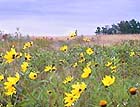Bring back hay meadows
Hay meadows are all but extinct, says the National Trust who is encouraging farmers to bring back hay meadows into modern farming


Romantic hay meadows, once the corner- stones of British farming, may be on the edge of extinction, according to the National Trust, which says that the last detailed study across England and Wales-20 years ago-showed that only 3% of those recorded in the 1930s still survive, a situation that appears to have worsened since then.
Hay meadows were located on the most fertile soils and were deemed so valuable that, as late as the Second World War, tenancy agreements usually prohibited ploughing them. Vast numbers were lost postwar, through non-organic fertilisers, drainage and the switch to silage-making as a more efficient, less weather-dependent method of storing grass for winter feed.
However, some farmers do still manage good-quality hay meadows and others are sus-tained through grants; the rest are maintained by conservation organisations and managed as nature reserves. Helen Buckingham, a conservation adviser for the Trust, says they provide a colourful refuge for plants and invertebrates that struggle in modern mono-cultural farming. ‘In contrast to species-poor, improved grasslands, hay meadows provide a rich nectar source in early summer, and are often alive with butterflies, burnet moths and bees.'
But Prof John Rodwell, an ecologist and hay-meadow specialist, believes hay meadows may yet have a role to play as farmers increasingly look to manage costs: ‘They can be very productive, with yields of six to 10 tons per hectare, using nothing but dung and some occasional super-phosphate and lime.
Hay itself is very nutritious and, provided the grass proportion in the hay is also high, the herbs can be appealing to livestock. When farmers integrate hay meadows into a more radical shift away from intensive management, there are other benefits, such as lower vet bills, premium markets for meat, and other marketable aspects such as tourism and well-being.'
National Trust hay meadows include those at Runnymede (Berkshire), Upper Wharfedale (Yorkshire) and Plas Newydd (Anglesey). For information on restoring hay meadows, visit www.floodplainmeadows.org.uk
Exquisite houses, the beauty of Nature, and how to get the most from your life, straight to your inbox.
Country Life is unlike any other magazine: the only glossy weekly on the newsstand and the only magazine that has been guest-edited by His Majesty The King not once, but twice. It is a celebration of modern rural life and all its diverse joys and pleasures — that was first published in Queen Victoria's Diamond Jubilee year. Our eclectic mixture of witty and informative content — from the most up-to-date property news and commentary and a coveted glimpse inside some of the UK's best houses and gardens, to gardening, the arts and interior design, written by experts in their field — still cannot be found in print or online, anywhere else.
